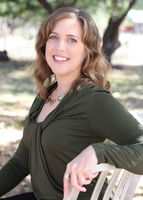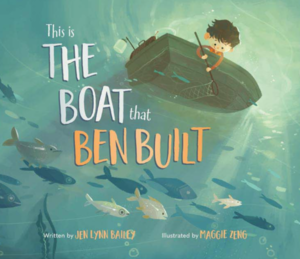Jen Lynn Bailey's New Picture Book Celebrates Both Northern Nature & The Cumulative Story Form
A cumulative tale is a story, song, or folktale that uses repetition, rhythm, and often humour to build to a story's conclusion. You may not have heard the term, but you know the form–think "There Was an Old Woman Who Lived in a Shoe" or even "The Twelve Days of Christmas".
One famous example though is the British nursery rhyme "This is the House That Jack Built", and it's that beloved tale that inspired Jen Lynn Bailey's picture book This is the Boat That Ben Built (Pajama Press, illustrated by Maggie Zeng).
Funny and sweet, the circular story follows young Ben on his boat as he explores a northern river, encountering a black bear, moose, goose, heron, and owl, all of whom become part of his tale.
More than just wordplay and fun though, This is the Boat That Ben Built is a love letter to the natural world and the ecological diversity of the northern landscape Bailey explores. It's a great jumping off point for talking to kids about nature and conservation, while still taking them on a rollicking adventure. For parents and educators, the book even includes a nonfiction postscript with fun fact and teaching suggestions that tie into the story.
Today we're speaking with Jen about This is the Boat That Ben Built as part of our Kids Club interview series. She tells us about where her love for cumulative stories comes from, how she left some key storytelling decisions up to her illustrator and was delighted by the results, and her favourite part of the life cycle of a book.
Open Book:
Tell us about your new book and how it came to be.
Jen Lynn Bailey:
My debut picture book is called This is the Boat that Ben Built. It is illustrated by Maggie Zeng and is published by Pajama Press. It’s a humorous fictional exploration of a northern river ecosystem with an intrepid young boatsman, and it includes nonfiction backmatter about the ecology and key species found in that ecosystem. In this story, young Ben sets out to explore the river equipped with a sturdy boat, some sample-collection gear, and his scientific curiosity. Along the way he meets a black bear taking a swim, a moose all wobbly and slim, a goose with a gorgeous grin, and a heron all proper and prim... but things really start happening after the owl HOOs loudly on a whim.
I first got the idea for this book because of my love for cumulative stories. I particularly loved The Napping House by Audrey Wood (illustrated by Don Wood) and Simms Taback's version of This is the House that Jack Built. I was finishing up my final semester in the Writing for Children and Young Adults Master of Fine Arts program at Vermont College of Fine Arts (VCFA), and I needed a break from writing the middle grade novel that was making up the biggest chunk of my creative thesis. So, I set myself a fun challenge: to try to mimic the rhythm and rhyme of the cumulative story This is the House that Jack Built, and set it in the woods.
OB:
Did the book look the same in the end as your originally envisioned it when you started working, or did it change through the writing process?
JLB:
The very first version of this story was called This is the Cabin that Ben Built and I imagined Ben to be a man who built a cabin by a river. He wanted to go for a quiet paddle in his canoe, but the animals who lived there had other ideas. In one version Ben ended up with a capsized boat in the river. It took me a long time to get the cumulative part of the story working, and to realize that the story was stronger when the focal point was the river and boat rather than the cabin. In the end, I settled on the version of This is the Boat that Ben Built that was published, and I left a lot up to the illustrator. For example, I didn’t specify the kind of boat Ben built (was it a toy boat? a real boat?), what he was doing on the river (was he fishing?), or how old Ben was. It was a nice surprise to see how Maggie Zeng and our editor Erin Alladin interpreted it: Ben became a boy who built a rowboat and explores the river. I also loved the addition of the adult character and dog who follow along on the shoreline.
Your CanLit News
Subscribe to Open Book’s newsletter to get local book events, literary content, writing tips, and more in your inbox
I also didn’t originally envision the book with nonfiction backmatter, but a mentor of mine advised me that it might have broader appeal if I included it. It turns out that this was what sealed the deal for Pajama Press, so I was glad I took that advice!
OB:
Is there a character in your book that you relate to? If so, in what ways are you similar to your character and in what ways are you different?
JLB:
I think I am like Ben in that I love to explore my surroundings. I observe for a long time and really try to understand what I am seeing and hearing around me. I am also a very determined person and I know that sometimes great results require great patience! I am different from Ben in that I don’t think I could lay back in a floating boat on a river surrounded by all those animals and relax like he does... but what a lovely way to spend a day that would be!
OB:
What do you need in order to write – in terms of space, food, rituals, writing instruments?
JLB:
I have a small office space that is filled with inspiring objects, books, and pictures. Things my kids have made me sit on my bookshelves, and my writing friends from VCFA join me in spirit through photos and knickknacks on display. I love to drink tea when I’m writing. Mostly I write on my laptop but when I do write by hand it must be in black ink. I have a set of pens that I prefer using which glide smoothly across the page in a way I enjoy.
OB:
How do you cope with setbacks or tough points during the writing process? Do you have any strategies that are your go-to responses to difficult points in the process?
JLB:
When I hit a tough point in the writing process there are a few strategies I fall back on. Firstly, I reach out to my writing friends and bounce ideas off them.
Secondly, I put the story away for awhile and work on something new. I find that when I return to it weeks (or sometimes months) later, I can either see where it went off track or I have come up with something new to try to fix it. Lastly, I try to fill up my creative bucket, so to speak. For me this means reading different kinds of books, watching great shows or movies, going to museums, bookstores, and art galleries, and doing things that allow my mind to wander like puzzles, knitting, or going on hikes. Sometimes I find that a combination of these things works best to get myself unstuck.
OB:
What's your favourite part of the life cycle of a book? The inspiration, writing the first draft, revision, the editorial relationship, promotion and discussing the book, or something else altogether? What's the toughest part?
JLB:
My favourite part of the life cycle of a book is the revision process. I love fine-tuning the language and thinking about rhythm and sounds, especially for stories I know will be read aloud. The toughest part is also the revision process! That’s because I’m trying to figure out if what I’ve put on the page is what is being communicated to my readers. For me, this stage involves sharing my work with critique partners and really listening to how they respond to the words, passages, and ideas. Through this process I also figure out what it is I’m trying to do in a story, and make sure that I articulate it clearly.
_________________________________________________
Jen Lynn Bailey’s passions for environmental science and education are evident in everything she does. After studying Integrated Science Studies at Carleton University and earning her Bachelor of Science in Education at Martin Luther College, she went on to earn her Master of Fine Arts in Writing at Vermont College of Fine Arts. She has worked on numerous wildlife research studies in the field and in the lab, and has taught both in an elementary school and in a college professional writing program. Today Jen is a policy and planning analyst for Science Promotion and Operations at the Natural Sciences and Engineering Research Council of Canada. Her first picture book, This is the Boat That Ben Built, combines her passions in an engaging introduction to ecology. Jen lives in Ottawa, Ontario.





